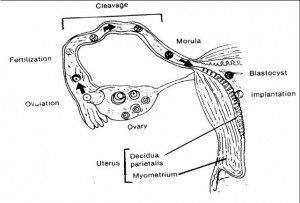a. The morula floats in the uterus for 3 to 4 days, gaining in size and weight. At this time, the hollow fluid-filled morula, now called blastocyst burrows into the uterine lining.
b. The outer surface of the blastocyst becomes covered with finger-like projections called chorionic villi. Chorionic villi aid in the process of implantation into the endometrium (decidua). Villi also manufacture human chorionic gonadotropin (HCG) which signal the corpus luteum within the ovaries to continue production of progesterone and estrogen to prevent menstruation.
c. Implantation normally occurs in the upper, posterior wall of the uterus. The point of implantation becomes the origin for the placenta and umbilical cord.
NOTE: See figure 2-4 for associated events of fertilization and implantation.

